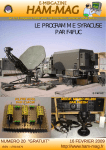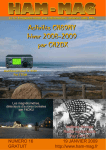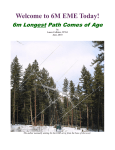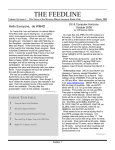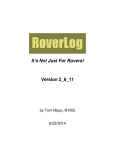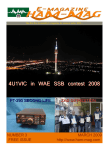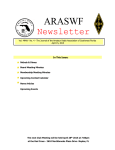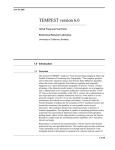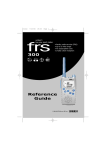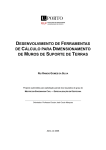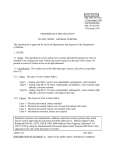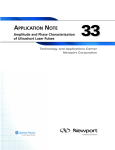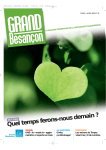Download January 2010 - Rochester DX Association
Transcript
R o c h e s t er DX a s s o c ia t io n , in c . rd x a .c o m 1947–2007 • 60 Years of DX in WNY Rochester DX Association, Inc Newsletter RDXA General Membership Meeting January 20th 7:30 PM This month’s program: HFTA terrain analysis Program, and N1MM Advanced Features, by Ken N2ZN Media room, right next to the EOC operations center. 1190 Scottsville Road Exit 17 (Route 383 South) off 390 Media Room Haiti Emergency Operations: ARRL The ARRL encourages US amateurs to be aware of the emergency operations on the following frequencies: 7.045 and 3.720 MHz (IARU Region 2 nets), 14.265, 7.265 and 3.977 MHz (SATERN nets), and 14.300 MHz (Intercontinental Assistance and Traffic Net); the International Radio Emergency Support Coalition (IRESC) is also active on EchoLink node 278173. I do plan to monitor these frequencies when I’m in the computer room. I encourage you all to do the same. The Podium January 2010 Paul Mackanos Well, now that we have had some really cold weather and some nicer weather, many of you have been heard in some of the recent DX and NAQP contests. It is great to hear so much activity from our RDXA Members, way to go gang! I know I have been having a lot of fun running my remote station and playing around in these contests, keeps me out of trouble. Several of our members have been activating the W2FU station and making some really BIG scores. I hope you all make the meeting on Tuesday, because Ken, N2ZN is going to give a brief program on N1MM and also a great program on Terrain Analysis. This is going to be very interesting, as Ken is an expert on these subjects. I look forward to enlightening my interest in the analysis program. Come on out and have a great evening with all of our fellow RDXA members meet, maybe a dinner before the meeting? Maybe W1TY will send out a dinner meeting invitation. See you all At the meeting. 73 de Paul K2DB WHISKEY TWO LIMA UNITED W2LU Many years ago, when real radios glowed in the dark, I got my first kick out of communicating by putting together a tin can/tight string telephone while in first grade. Before long it was a cat whisker galena crystal radio that would pick up two or three of the local broadcast stations. By fifth grade I was carrying my ARRL handbook back and forth to school and starting to realize that “ham radio” might be a great hobby. After three bus trips from New Hartford (Utica) to Syracuse I finally passed the 13 wpm code test and in 1951 landed my Class B license and W2FZJ. The second failure was because the FCC examiner said there were two letters in the middle of a nice long run that he couldn’t read – I guessed right on one, but wrong on the other so he failed me. My first experience “on the air”, before I got my license, was with a buddy across town. We each had old phono oscillators to which we added michrophones and longwire antennas, which allowed us to talk the quarter to half mile between our houses. That convinced me that ham radio would really be great. After three summers of lawn mowing I saved enough to go down to the local radio store and buy a National NC-57 . So with that, a single 6V6 from the family living room radio, a crystal for 3570, and an off centerfed longwire I got on the air. The transmitter had output coils wound of bell wire – one set for 80 and a second set tuned to the second harmonic at 7140. The next project was big time – a pair of the venerable 807’s. At first it was CW only. Then I read something about “cathode modulation. So, with a small transformer in the 807 cathode lead and a carbon mike and battery I was on AM. Later with a pair of TZ-40’s, a modulation transformer and an old speech amp I was on real AM. And then there was the single tube Clapp oscillator VFO. With about 2 little dial divisions per 100 kHz on 10 meters and a crystal calibrator, riding the band edge (28.500) was a dicey proposition, but all the more fun. In the meantime I was able to put together a three-element ten-meter beam and talked my parents into letting me put it on the roof with a surplus prop pitch motor ($5 surplus from nearby Griffis Air Base) in the attic. The 10-meter yagi was later upgraded to the pictured four-element 10/20-meter beam. With that setup and good sunspots I managed to confirm just about enough for my DXCC on te meter phone. By that time the hook was firmly set and it was off to RPI to learn what E=IR and SWR were really all about. After school and landing a job as an EE with General Dynamics in Rochester I moved up to a classy NC183D and a Hallicrafters HT-32, built an amp with 4 811A’s out of surplus GD parts and a three element three band G4ZU beam. From there I was off and running, up grading a step at a time to the current station. All along the way working for radio/electronics companies and picking up “neat stuff” which became available from those who lacked appreciation for it. I managed to get over the 20 wpm hump in 1972 and upgraded to extra and W2LU. My current station includes an Icom 756 PRO 2 and a home made single 8877 amp. Antennas include a home made 7-60 MHz LP on a 100 foot tower ($20 worth of GD scrap steel) , a reconditioned TH-6DX at 45 feet, three bent vertical dipoles on 80 and three quarterwave slopers on 160. My primary interests are low band SSB dx’ing and antennas in general. It’s really been a great hobby and has been a constant in my life for nearly 60 years. We’re all so lucky to have the chance to enjoy it. The pictures show my 1953 station. On the desk is the NC-57, the prop pitch control box and the speech amp. Unseen is the BC-453 “second I.F.” and VFO. In the rack is the pair of 807’s along with the TZ-40 modulator, power supplies and an antenna tuner and note on the antenna changeover relay on the wall. The housetop beam is for 10 and 20. Basically they are 20-meter elements with series/parallel-tuned circuits inserted in the center of each element, which allowed separate tuning for ten and twenty. Today’s station includes the Pro 2 with the 8877 amp to the right. Above the 8877 amp is an antenna tuner and power meters. Above the Pro 2 is a Transworld T-1000 solid state kw . To the left are mostly antenna control boxes and switching. Immediately above the Pro 2 is an RF routing box. In the rack to the right are a couple of older amps 4 811A’s and a 41000A, just taking up space now. Today’s antenna system can be seen with the LP on the top of the tower and the TH-6DX at about 45 feet. The 80 and 160-meter wires are hung from the top of the tower but are hard to see in the photo. I also never believe there is a “dead” band, just everyone thinks it so no one is on it. Maybe after these last few years I’m disbelieving that but in the year end review of logs from W2CCC, I’m quite pleased with the spread of contacts AND bands. The 9th of July saw a HUGE 6m opening, 41 grids in an hour! (the 21st of June, 4th 5th and 6th of July also had openings... the 7th of July had a very strong Caribbean, South American opening). The 4th of October was unreal on 160m, 11 countries that nite with 7 new ones on 80m as well. The 14th of November saw a surprising opening on 12m, worked 4 countries that day. My most memorable Q’s from W2CCC this year were probably VU2PAI on 17m CW then H44MY shortly thereafter on 20m. HV2A on 80m and K4M on 160m wasn’t too bad either. As can be expected, not too much on 10m, even though those LU’s (not Gene) do add additional points at the end of the contest but once confirmed, no real need to call CQ there outside of a contest while at the “bottom”. Odd how 12m and 15m found their way into the log on several occasions, short openings but because everyone thinks the band (s) are dead, no one bothers to look there. W2CCC now holds DXCC, VUCC and WAS all within 4 years with the “tried and true” wire setup and until just recently, 100w. ______________________________________ Who will be next month’s bio ????? Thank you Gene. Let’s line up Bio’s for the rest of the year. I would love to hear how you got started in the hobby and what else do you do in your life (if there is anything besides amateur radio). Send your bio to Dave N2CK, the newsletter publisher and see it in print in upcoming months. We’re lucky a cell may work up there so no internet or dial up phone, just like the “old days”, I just sit.... spin the knob and then try to figure out where the transmit frequency is after hearing the pileup. Shake the hand of the “old timers”, it STINKS when you’ve got a beat on the guy but he NEVER ID’s!! Over 30 requests for Herkimer County in the NYQP so far, can wait till next year, some CW will probably add to those requests. Nice job to one and all. ______________________________________ In the log W2CCC - 2010 (non-contest) DX Report CE1/K7CA (160m CW) 5R8HX (17m CW) OZ1CTX (160m CW) S52/HB9AMO (40m CW) ZC4VJ (40m CW) 5N50K (17m CW) K2CS I’d have to believe the biggest DX news of the month must be the SFI returning to “normal” levels. From my very non-scientific eyes, a few charts on the web seem to indicate we haven’t seen “90” since 2005! Not that all’s been lost since then. It’s funny, I guess if you’re a real “DXer”, you’ll always find stuff to work. Since I’ve only been around for 1 peak (and subsequently 2 bottoms), many of my elmers said “Knock off the lowband stuff when you have a chance”. See you in the pileups. Best DX es 73, Chris, K2CS: Atlantic Division DXAC ______________________________________ Contest Chairman Update Well, here we are halfway (or more) through this contest season; hard to believe that it is going by so fast! It seems like yesterday that we were all jumping up and down with excitement about the upcoming NYQP-and now, the NYQP is just a memory of 3 months ago. Of course, there is always next year, but that can only come after the log checking guys (who are they, anyway?) get their butts in gear and tell us who won the thing. I hope you are all having fun so far this season, because that is what it is all about, anyway. As always, you should submit your scores to the score grid on RDXA.com, and be sure to submit your logs to the contest sponsors. Since all of the annual RDXA awards are based on what is on the grid, keeping your scores up to date is a good idea. Speaking of which, if you haven't put your 2008-2009 scores (last year's) up on the grid, then this would be a good time to dig them out and post them. I am in the process of compiling last year's scores in order to have awards ready for this year's Awards Banquet in April, so if you don't want to be shut out of the action, get those scores posted. Speaking of awards...remember last year when we had a meeting devoted to awards; new ones, old ones, DX awards, contest awards, etc (Of course you remember, right)? The time has come for the DX awards to come back. If you keep track of your DX worked like you should, send me a summary of your 2008-2009 activity (overall countries worked, countries worked per band, per mode, if you used high power, low power, or QRP) and you can get in the running for the new DX awards. Even easier...send me an ADIF export of your DX log for last year and I can figure it out for you. Most logging programs have a report that does this anyway, but I'll give you a hand with it if you are unfamiliar. Back to contesting after that short, DX inspired break... Upcoming contests for this month: ARRL January VHF Contest-1900Z, Jan 23 to 0400Z, Jan 25 BARTG RTTY Sprint-1200Z, Jan 23 to 1200Z, Jan 24 CQ 160 Meter Contest, CW-2200Z, Jan 29 to 2159Z, Jan 31 Minnesota QSO Party-1400Z-2359Z Feb 6 Delaware QSO Party-1700Z, Feb 6 to 2359Z, Feb 7 New Mexico QSO Party-1500Z, Feb 7 to 0300Z, Feb 8 NA Sprint CW-0000Z - 0400Z Feb 7 CQ WPX RTTY Contest-0000Z, Feb 13 to 2359Z, Feb 14 NA Sprint SSB-0000Z - 0400Z Feb 14 ARRL DX CW Contest-0000Z, Feb 20-2400Z, Feb 21 CQ 160 Meter Contest, SSB-2200Z, Feb 26-2200Z, Feb 28 North American QSO Party, RTTY-1800Z, Feb 270600Z, Feb 28 So, there is a pretty full calendar for the next month...and they are all good ones. Plenty of opportunities to get a contesting fix between now and the next newsletter. Out of all of the contests I listed above, the 160 meter contests will probably be amazing. Last year's 160 contest conditions were what some people were calling the best ever in history, and conditions on 160 so far this year have been excellent. Of course, 160 meter propagation is unpredictable at best, but things are shaping up to be good. We may only have this year (and maybe one or two more) for great lowband conditions before the sunspots start popping up again and conditions worsen on the low bands. Get those wires snaked up through the yard and trees any way you can-you won't want to miss it. One thing that I have been pushing for quite a while is the team participation for the North American QSO Parties-we have had good success doing this in the past, and while we didn't get enough to have a team in the CW contest, we may have enough to do the SSB contest (not sure as of this writing, though). However, with over a month and a half to go before NAQP RTTY, I think we should be able to pull a team or two together. Start thinking about it now! The contest is 12 hours long, and single ops can only operate 10 hours out of the 12. Let's keep this idea going-did you know that RDXA has fielded teams for most of the NAQP events for the last three years? We have a pretty good track record, and it's not all about having a winning score-it is about getting on the air, being active, and having a good time doing it. I'd like to see 2 teams for the NAQP RTTY-that means 10 people. I already have a few commitments, so clear those calendars now, and get on the team(s)! Now, some interesting websites that I have enjoyed reading over the past month or so. At CT1BOH's website, the results articles for all of the CQWW SSB and CW contests from the beginning of the contest (1948) until now are posted. They are scans of the original magazines, and are very good quality. If you want to catch up on some neat CQWW history (or just find out how your fellow RDXAers did in the 1966 CW contest), go to www.qsl.net/ct1boh/cqwwhistory.htm The N1MM Logger documentation has been moved from the old "help file" style into a new online wiki format-check it out at http://n1mm.hamdocs.com. You can still download the complete user manual in PDF if you want, though. If you have never visited the Contest Compendium at http://wiki.contesting.com, you are missing out on a lot. There are a lot of great articles there, including stuff written by some of the top operators and station builders out there today. Definitely worth a look, even if you may have read some of this stuff before. As advertised on the CQ-Contest reflector, the PVRC has been holding webinars about various contesting topics over the last year. Chances are, if you have a hectic schedule, you may not be able to make one of these webinars live, but the video files are archived on the web, and you can watch them when time permits. The one called "When Giants First Walked The Bands" about the early years of multi-multis is really interesting, if not only to see all the old equipment and big antennas. Check it out at http://www.casadelcrappo.com/pvrc-videos/ (that's a great domain name, by the way). That's all for this month-see you at the meeting on Jan 19, and on the air otherwise! 2009 DXCC Year End Review By W1JR, Joe Reisert DX wise, the year 2009 was very similar to what we experienced in 2007 and 2008. There were approximately 284 DXCC entities activated during 2009, about 10 fewer than in 2008. Unfortunately several Dxpeditions were delayed (hopefully only into 2010), had to be cancelled or were thwarted from operating for one reason or another. CW still did not die since there were at least 255 entities active on CW but fewer than in 2008. Many stations with no code licenses, especially outside the USA, have been operating on CW and some have shown great CW skills. One side effect is that we are seeing much more "599 TU" operations with not as much skill to copy other information. Some now say that we have developed a group of computer "code readers." At the same time, some SSB operators have noticed an increase in activity, especially during SSB contests. The solar minimum first promised for October 2007 and then August 2008 turned out to be incorrect. Despite some recent small sunspots from the upcoming Solar Cycle 24, propagation hasn't really taken off. According to NOAA, it now looks like the Solar Minimum occurred in December of 2008. NASA is now using a new technique called helioseismology to monitor the solar jet stream which is believed to cause sunspots (http://science.nasa.gov/headlines/y2009/17jun_jetst ream.htm). They say the stream is delayed which portends that the start of Solar Cycle 24 will be later and hence shorter lived with a lower peak (probably less than 90 sunspots) peaking in May 2013. We hope that the long delay doesn't mean we will be having another Maunder Minimum! Only time will tell if we are finally going to see improved HF propagation. Very few solar disturbances occurred in 2009. A small disturbance occurred at the end of March, another at the end of October during the DX contest, and a larger one starting in mid-December. Ironically the later didn't noticeably improve propagation. The solar flux, the main propagation indicator on the higher bands, stayed mainly at 70 or below all year. In fact most of July, August and September saw one of the quietest Suns in over 90 years with A=66 on August 9th! In early and late December, we experienced an A=0 and K=0 on several days. I have never seen this happen before. However, the solar flux reached 88 on December 17th, the highest level since December 2006. When there are so few sunspots and low solar flux, good DX propagation is still mainly confined to the lower HF bands. Check the daily propagation reports at http://www.dx.qsl.net/propagation/ or the weekly ARRL Propagation Bulletins by Tad Cook, K7RA. Since official sunspot numbers are a moving index that is 9 months after the fact, the waiting game for Solar Cycle 24 to take off goes on! Despite the lack of significant sunspots, there was still plenty of DX activity in 2009 albeit mostly concentrated on 160 through 17 meters. 160 Meters seems to be getting lots of DX activity but possibly at the expense of 80 Meters which does become active during contests. Several more entities have received permission to operate on 60 Meters bringing the total users almost to DXCC level. 40 Meters is still the night time breadwinner. The expansion of this band from 7100 to at least 7200 KHz for many of the Worlds entities has generated lots more activity, especially during contests. 30 meters is becoming very popular, sometimes being open 24 hours a day. 20 Meters is still the daytime breadwinner although 17 meters is sharing some of the load. During this year 10, 12 and 15 meters were spotty at best and then mostly only on the North/South or skewed paths. Some sporadic E propagation especially during June, July and December did enhance HF DX somewhat but this was not due to increased sunspots. Equipment and operating techniques are still improving especially in the area of dynamic range and low noise receiving antennas on the lower bands. Newly manufactured equipment can often be upgraded by the manufacturers offering software updates via the Internet not only for transceivers but antennas, rotator controls, logging programs etc. New equipment offerings were few this year except for some panadaptors, speech processors and improved antennas such as the 43 foot vertical for multi-band operation. In particular there was a rise in the use of SDR (software defined radios) which thrive on software updates. Even some instrumentation such as the new Array Solutions VNA-2180 Vector Network Analyzer, a new powerful measurement tool, can be updated on the Internet. Of course, software, especially logging programs is constantly being modified or improved. Internet use and abuse by Amateurs continues to increase especially for spotting clusters. The DX clusters are an amazing tool for finding and spotting rare DX. One popular one is "DX Summit." Clusters are a far cry from the way we used to spot DX using either the telephone, spotting frequencies on HF or VHF repeaters. However, there are several downsides. All too often incorrect or extremely rare callsigns (not on the air at the time!) are spotted. A rare callsign can cause a huge pileup that may even cover up the DX station. Listen before you call to be sure it is the right station and especially if there are special instructions such as listening UP! In these days of seldom signing callsigns, never reply solely on the accuracy of the spot as you may receive a NIL (Not in Log) to your QSL request. During 2009 there were often two or more DXpeditions operating simultaneously and often pileups coincided or overlapped. Also don't post spots with bragging or QSY request addendums. No one cares and in the case of DXpeditions, they seldom are continuously connected to the clusters so they usually don't see your spot! Many DX stations, especially the large scale DXpeditions now update their logs on the Internet during their operation. One of the most active Internet activities in 2009 was the use of the ARRL Log Book of the World. This was spurred on by the introduction of the ARRL "Triple Play Award" which was completely awarded on the basis of LoTW entries. Also, several of the large 2009 DXpeditions also put their logs directly into the LoTW. There are now over 250 million LoTW QSO entries and over 35,000 LoTW users, an increase of almost 25% over 2008! Most major contest logs and some awards now have to be submitted via the Internet. Operating techniques are always changing. Split frequency operation, especially by DXpeditions has its own problems. Often calling stations are not aware of the split and QRM the DX. During several of this year's major DXpeditions I carefully monitored the DX station frequency. Often someone would hear this relatively clean frequency, jump right in, hear the DX station giving reports, imagined that they had a QSO and with impeccable timing would hear the DX station say TU and think they had a valid QSO! It goes without saying that if you aren't copying the DX station well enough to have a valid QSO or aren't aware of what technique is being used by the DX station, DON'T CALL! This is a good reason to check logs if they are posted on the Internet rather than receiving back a NIL reply to your QSL request. However, this doesn't mean that we should call continuously and later check the internet hoping to see if your callsign is in the log! Also, there are the usual problems with "frequency policemen". If you can't refrain from saying something to the interfering stations, drop in a SHORT reminder like UP. Sending a long string of UP UP UP UP UP etc. or calling a station a lid often does more harm than good and often QRMs the DX station. Of course, obscenities are NEVER appropriate. Also, try not to rag chew on frequencies frequented by rare DX. 3.795, 14.195 and 14.260 (IOTA) MHz are just a few frequencies that come to mind. You may not hear the DX station but transmitting on those frequencies will make it difficult for others that are experiencing better propagation than you are. Many pirate operations showed up in 2009 using existing or unlicensed callsigns. 3W2BV, 3Y0Q, C31LJ/M, HV3VO, JW4JLK, OD5GR, OY2JT, R1FJA/P, TK0M, TU2FQ (on CW), YI1SR, YI1HR, YI1HRP, ZD9BNA, ZD9HP, ZK3T, ZL5SP, ZL9C, and ZL9AI are just a few that come to mind. Some stations using YU8 callsigns were also observed but most of them were in located in Serbia, not Kosovo. Those that were QRV from Kosovo during 2009 were YU8/IW0HEU, YU8/HB9BF and YU8/HB9EKC. Likewise, some recent operations are still not accepted by ARRL such as 5N/LZ1QK and 9Q/DK3MO. 4U1AIDS operated from Switzerland and does not count the same as 4U1ITU. Also some DXpedition callsigns were even pirated during their operation. WFWL (work first, worry later) these stations but this does little good if they are a pirate so sending a QSL is a waste of time and money. There were a few major DX items of interest in 2009. One of the biggest surprises was when the ARRL Desk was able to certify that the 7O1YGF operation in 2000 was valid. Furthermore, 7O1YGF QSLs are still available and their logs were placed on the LoTW! Other highlights were the K5D operation from Desecheo Island and K4M from Midway Island, areas that have restricted access and require special permission from the U. S. Fish and Wildlife Service (USFWS). Let's hope that these superb operations and the work of the KP1-5 Project will yield future operations from other restricted areas, especially KP1, Navassa Island! FT5GA was finally operational after a long delay. Big disappointments this year were surely the very limited operation of ZS8T from Marion Island (only 85 QSOs) and FT5WO from Crozet Island. Even though January (with shortened daylight for those in the Northern Hemisphere) is a tough month for DXers, there were many entities activated. New Years Day (and this year with a long weekend) usually is a great time for DXing since many semirare entities often show up. January activity from semi-rare entities was helped in 2009 by operations from E44M, J5UAP, FW8DX, JD1BMM (M/T), VP8DIF (SGA) and a large group of YLs from the Falkland Islands. TS7C was also active and apparently set a new RTTY world record with over 12,000 QSOs. I'd estimated that 200-210 DXCC entities were activated during January, about 10-20 less than in the same period in 2008. With some luck and good propagation a very active well equipped DXer could have worked 180-190 DXCC entities. February was also a very good month for DXers with 160 meters still yielding some very good DX and 17 meters improving. 3B7FQ, FH/G3SWH, FP/KV1J, FW5RE, several HVs, PS0F (F/N), S79JF, T27A, TN5SN, and TT8SK activated some semi-rare entities. A French group activated several Antarctic area entities. However, the biggest excitement was the large scale operation (20 operators!) of K5D from Desecheo Island logging over 115,000 QSOs! If you didn't work them, you probably didn't try! As the year passed on there were many semi-rare operations. March brought us DXpeditions such as H40FN, VK9AA (C/K), VK9LA (LHI) and VK9GMW (Willis I.). April followed with 3B9/SP2JMB, YK1BA, and S04R. May had operations such as 5V7PM, ZK2V (who activated 60 meters for the first time), and 7P8R. DX tends to slow down in the middle of the year as the Northern Hemisphere experiences longer daylight. Regardless of the time of year, June gave us S92LX, TZ6EI and 5J0BV (HK0A), the latter two were both also on 6 meters. July had another group operating both 3DA0 and 7P8. August saw operations from OJ0 (Market Reef) and 4W6AL. DX typically increases as we move into the later third of the year when days shorten in the Northern Hemisphere. September saw activity with FO/A, T2, T30, ZL7 and finally FT5GA from the long delayed very rare Glorioso Islands. The later was a military working group on a mission so operations had to be in their spare time. However, over 50,000 QSOs were still made on all DX bands and the logs were posted on the Internet and LoTW. October was a confusing month with several DXpeditions all operating at the same time including FT5GA. 3D20CR activated Conway reef and there were operations from FO/M and PY0T. After overcoming operating permission and several transportation problems, there was a shortened operation from Midway Island by K4M. They still managed to exceed 60,000 QSOs and made over 2,600 QSOs on 160 meters. November saw operations from A25, CE0Y, T30, and VK9X. Also active was TX3A from Chesterfield Island making almost 37,000 QSOs between fishing and diving! The later, a two man DXpedition, emphasized the lower bands and uploaded all their logs on the Internet as well as LoTW while still on the Island! December ended the year with operations from 5T, C56, CE0Z, J5 and SV2ASP/A. And now the Drum Roll please. Those entities that were NOT believed to have been active during 2009 are as follows: Africa (16): 3C0, 3C, 3X, 3Y/B, 5A, 5U, 9X, D6, E3, FR/J, FR/T, FT/X, FT/Z, T5, VK0/H, and ZD9. Antarctica (1): 3Y0 (Peter 1). Asia (9): 1S, 7O, BS7H, BV9P, EZ, P5, VU4, VU7, and XZ. Europe (3): 1A0, JX, and R1M (MV Island). North America (7): CY0, CY9, FO/C, KP1, TI9, XF4 and YV0. Oceania (13): 3D2/R, KH1, KH3, KH5, KH5K, KH7K, KH8S, T33, VK0/M, VP6/D, ZK3, ZL8, and ZL9. South America (5): CE0/X, HK0/M, PY0/S, VP8/O, and VP8/Sand. Note that some rare entities may not be on this list. This is because some operations, however short, were conducted. Examples are 9U1P, E51WL (6 meters), FT5WO, VK9WBM (6 Meters) and ZS8T (only 85 QSOs) to name a few. A list of DXCC entities that have believed to have not been activated in the last 6-10 years are: 3C0, 3Y0/B, 7O, E3, FR/E, FR/T, FT/Z, HK0/M, KH1, KH5K, KP1, P5, and VK0/H. In addition, there were some short or low QSO total operations from some rare entities such as FT5/W, VK0/M, XZ, ZL9 and ZS8/M. This shows that an avid DXer working hard at DXCC in the last 7-10 years could have been able to make the DXCC Honor Roll. The list also serves as a guide to those planning DXpeditions to rare entities. 2010 will start with many planned operations. We hope that the excellent cooperation with the USFWS that permitted the recent operation from Desecheo and Midway Islands will help to open the door for operation from other entities such as Navassa Island which has similar environmental restrictions. 2009 operations from D6/F6AML and EZ were scuttled because of licensing problems. Let's hope these issues can soon be resolved. Among some of the rarer entities rumored upcoming operations in 2010 are 3B9, 3W, 9X, CY0 (delayed from 2009), E4, FH, FO/A, FW, H40, J5, S2, T31, VP8/H, YV0, and ZK3 to name a few. Others maybe in the planning stages and not yet announced. Many thanks to W3UR, W9KNI and K7RA for their valuable inputs to this report. The possibility of new entities being added to the DXCC list still exists. Kosovo may finally obtain all the needed requirements for separate status. The status of PJ (Netherlands Antilles etc.) can change as some of these Dutch Islands may become more independent from the Netherlands but probably not until late 2010 or early 2011. If so, a few new entities will be created and some will be moved to the "Deleted List." A recent change in the DXCC rules will revert deleted entities to the Deleted List instead of being completely removed (as if they never existed) as previously ruled in 1998. Hence, the present DXCC active entity list still stands at 338. Propagation 11 years ago Sunspots should surely reappear and Solar Cycle 24 will start to improve propagation on the higher HF bands. Look for the solar flux to go over 100 with low A (<20) and K (<3) indices. Solar wind below 300 KM per second and dynamic pressure less than 0.5 nPa as show on NOAA Space Weather are also good indicators. Finally, DX means many different things to many people. Some DXers are only interested in the ARRL DXCC Honor Roll and soon run out of interest and challenges. Others pursue the never ending ARRL Challenge competition. Some like to chase Islands for the IOTA (Islands on the Air) program by the RSGB. There are approximately 1200 IOTA Island Groups and many have never been activated so there are lots of challenges. For the last several years, CQ Magazine has reinstituted the year long CQ DXCC Marathon to see who can work the most entities in each calendar year. This program has a few more challenges by also adding several entities recognized only by CQ Magazine but not on the ARRL DXCC list as well as working all 40 zones. And there are the never ending DX Contests. There are lots of things to do. Don't let the airways die for lack of activity. Stay active and join the fun. Best of DX to you in 2010 and here's hoping to see you in the pile ups. Ed. Note – the above article was reprinted with permission from The Daily Dx (www.dailydx.com). Receive the Daily DX report for 2 weeks free at http://www.dailydx.com/trial.htm Upcoming Programs K2FX st Feb: K2FX to present 1 Time Towers Mar: Program on Clusters and Filtering April: W2FU on Green Heron Products May: Field Day June: More Field Day AD5Q’s notes from Cycle 22 January 1999 Forecast Flux Range 94 - 239 The solar flux peaked above 180 for the first time in the new cycle, but has dipped below 120 as I write my final monthly forecast. This series began in February 1988, and this article completes the collection with exactly 11 years of seasonal documentation. It has been a good run, and I have learned a lot in the process of writing the forecasts. I feel fortunate in that none have written to point out errors in the predictions. I know of none, though I am fully aware that my reporting on WARC bands and low bands has been superficial and inadequate reflecting the deficiencies of my own station. Perhaps someone will pick up where I leave off hopefully reflecting the DX perspective from a different continent or hemisphere. An archive of the complete set of articles has always been available from my website, which will soon be reorganized so that articles from the last cycle can be selected by month and solar flux range for use in the current and future cycles. You will always be able to find an article from the last cycle that will forecast current seasonal trends in DX conditions. Other propagation gurus will continue to keep you posted on current conditions on the sun. But -- the above paragraphs were off topic. It's January and nighttime covers the Arctic. Polar paths are difficult and certain parts of the world are hard to reach on all bands. The dip in solar flux to 120 is temporary, and we currently do not have good coverage into Europe in the morning on 10 Meters. A rebound in the flux would open a window to all of Europe, but paths to Russia will still be difficult from Texas because of the Arctic night. On 15 the openings are broader, and on 20 we get regular polar openings at sunrise and sunset. Polar openings on 20, however, are better at any other time of the year. With a high solar flux, nightpath propagation returns to 20 beginning in February. This year, we can expect this improvement primarily during March - and hope for a flux above 175 in late February for the ARRL CW contest (and excellent running rates all night). 20 will be a nightpath band most of the year. Currently, 40 is quiet and really excellent. European signals are loud all evening and well past midnight, with lots of activity. The quiet conditions will continue for another couple of months - longer at higher latitudes. Over the next several months, the most spectacular seasonal phenomenon will be the improvement in nightpath propagation on 15 Meters. This peaks in late spring, bringing Asian openings in the morning, Europe through the evening, and polar openings almost round the clock. We can expect these conditions this year. On 10, there will be some improvement in the spring as daylight spreads over the Arctic. Later in the spring (when 15 opens round the clock), 10 will deteriorate as summer approaches. Spring DX on 10 is so-so, and is most spectacular in the fall. This fall, with a certainty of higher flux levels, 10 will be at its best. For January, early evening band closings on 20 are a problem. Still, this is the best band for reaching remote parts of the world that are usually worked via the north pole. These windows are narrow, and the Antarctic long path is often the best alternative into southern Asia. So here I conclude this final propagation post - a nutshell summary of the exiting year ahead. For greater detail, find the complete series of articles at "http://www.qth.com/ad5q I thank you all. 73 & DX de Roy, AD5Q http://www.qth.com/ad5q/ The geomagnetic field is expected to be at predominantly quiet levels for the forecast period. More at: http://www.sec.noaa.gov/radio/ Working with SMT K2RNY I was lucky in that I was granted my Christmas wish and got a AMQRP Micro908. Santa ordered it for me with every option but the DSP. This meant that I have the motherboard and a daughtercard (DDS) to assemble. Well, in order for the AMQRP folks to keep the size down yet make it feature rich, they resorted to using SMT size 1206 parts for most of it. Now what so I do? Well, I began doing some research on how others work with SMT on a project level like this. I want to share with you tips and tricks I found worked for me. EQUIPMENT: First of all, you gotta get prepared. These components are tiny. You can place about a dozen 1206 size resistors on a regular postage stamp. Small….. So, For an equipment list, I recommend a small soldering tip, one that resembles sharpened pencil. You should get a lighted magnifier and a good set of long tweezers. I also used a PCB vise. Use very fine solder. AMQRP gives you solder with the kit. I also used a small saucer to hold the parts I was working with. WORKPLACE: Set yourself up in a spot that you can stay in until you are done. Set the vise in the middle of the workplace. My setup consists of a bench in the basement with a static mat and the vise in the middle of it. In case you “flick” a component, chances are it’ll still land on the workplace. Be neat. Neatness really counts with this stuff. ASSEMBLY Forecast of Solar and Geomagnetic Activity 13 January - 08 February 2010 Solar activity is expected to be at very low to low levels for the entire forecast period. Isolated moderate activity is possible from 01 - 08 February with the return of old Region 1040 (N30, L243). No proton events are expected at geosynchronous orbit. The greater than 2 MeV electron flux at geosynchronous orbit is expected to increase to moderate levels on 14 - 15 January. Normal flux levels are expected during the rest of the period. The SMT capacitors I got were not marked. Nothing at all. Neither are the inductors. Moral of the story is to work with one component type and value at a time. If you decide to mount all the capacitors and dump them all in a dish, you are done. So, you place the board in the vise under the lit magnifier and using your tweezers, center the component on its pads on the board. Tack one end of the component to its pad to hold it there. Go to the opposite pad and solder it in. Little is best. Solder blobs are your enemy. Then return to the pad you tacked and solder that one. How I handle the SMT IC’s is to not use solder at all. Just a hot tip. There is enough solder on the pad to hold it down. Tack one pin, then tack the opposite pin. Then press on each pin. You’ll see it hit the solder and that is good enough. ENJOY Remember, this is fun. You are doing this for the enjoyment of it. Take your time. If you do a component a night, so what. If you have problems getting the IC’s lined up, ask for help. Remember, solder is not necessarily your friend when building with SMT. A little goes a long way. I hope these tips help you out. They worked for me and my Micro908 passed all the tests first time. Carey Magee, K2RNY Persistence and Internet Wonders – Rick W1TY/W2RTY During RTTY Roundup earlier in January I was disappointed in the quality of the decoders that I was using. N1MM was my choice of software and actually the first time I had used it in a serious RTTY contest. My options were to go back to Writelog using a P-II computer with a HAL P-38 RTTY modem or move to my P-III, and deal with N1MM not having a P-38 driver. I was so impressed with some of the N1MM features that I wanted to stay with it, but using just MMTTY to decode was not acceptable. In this configuration I have the P-38 and RITTY decoding on the P-II using a separate monitor. Can’t click on those two decoders, so frustration set in. I was the typical alligator, 1500 watts out and garbage coming in. Paul, K2 Dead Battery (he understands this) suggested that I put out a shout for a HAL DXP-38 modem. It acts the same as my P-38 but is a serial port connection to the contest computer rather than the P-38 which is an ISA slot circuit card. N1MM is happy using a DXP-38! So out went a “want” to the RDXA, RARA, RVHFG and WNYDXA mail lists. The DXP-38 is available new for $495… a bit steep for the frugal. Searches in the past have found a few “DXP’s” offered only to be snapped up within hours. I was amazed that somehow my wanted posting made it to the GreenKeys website and within three hours I had an email from Texas offering a mint DXP-38 for $160. Imagine that? I was prepared to pay about $275 for a used one. Herb K5HG sent me the HAL modem before my check even arrived. He said he always can trust a RTTY guy! K2DB and I used the cable from the P-38 and then met the real challenge of the installation. Plug and Play? NOT. N1MM needs to load an initialization file of the typically cryptic hex commands. Adding to this, I wanted two decoders active simultaneously. After a lot of trial and error a strategy appeared… read (not just browse) the N1MM manual! A lot of specific details had to be followed in sequence, but success resulted. A number of hours followed by a number of smiles. Now the “DXP” and MMTTY print side by side. As good as MMTTY is, the difference in quality is immediately apparent on weak signals. Thanks to K5HG for his trust and K2DB for his help. N2WK supplied a DXP manual for me to copy. Next up, WPX RTTY in February! Hope to print you on 40 meters. And remember, RTTY Rick says “Friends don’t let friends use AFSK” W2BSN Returns My Memories – Rick W1TY In 1965 this future RTTY Ranger had his Bar Mitzvah. One of my gifts was a Hallicrafters S-120 receiver (540 KC to 30 MC). Not much on quality, but what does a 13 year old know? In the mid 1970’s, I sold it to my best friends brother. Gone and forgotten. Fast forward to Fall 2009. The phone rings… Boston calling! “Hey Rick, how would you like your receiver back?” Sure would! Not many of us get their first radio back! Open box. Plug in. Listen to hiss, pop and crackle. I contacted Lynn Bisha W2BSN for advice. Surely an AWA member would have the guidance I needed. Simply put I heard “Let’s fix it!” Today we did just that. Clip off a cap and add some new ones. Spray liberally with lube for the dial shafts and remove the oxidation from the wafer switch contacts. Presto! WHAM 1180. Unfortunately we were listening to Rush Limbaugh. Lynn did not have a filter for that! Thanks for the memories, Lynn. Combined RDXA/RVHF Awards Banquet The combined awards banquet will be held on April 17th at Nick’s Sea Breeze Inn. Mark the date on your calendar (now would be good!) and plan to attend. Additional details will be forthcoming. Hamfest calendar for 2010 K2DB Elmira Winterfest Saturday, 27 February 2010 Lancaster Winter Hamfest Sunday, 14 March 2010 RAWNY Flea Market (Last year Tuesday, 14 April 2009) Dayton Hamvention Friday/Sunday 14-16 May 2010 Rochester Hamfest Saturday, 5 June 2010 Butler Hamfest (PA) Sunday June 6, 2010) PROS Hamfest – Chaffee (Last year Saturday, 13 June 2009) GRAM (Batavia / Alexander) Hamfest (Last year Saturday, 1 August 2009) Lancaster Harvest Hamfest (Last year - 5 October 2008) Elmira Hamfest Saturday, 25 September 2010 RDXA Apparel Update K1PY Ran across the RDXA apparel box, and thought I'd update the membership of the few items still available. Green golf shirt, RDXA patch, with pocket, XL $17 Green baseball caps (2), RDXA patch $13.50 each RDXA Yellow FD National Champion T-shirt, L $12 Reserve one for yourself as a Holiday gift! Will have in my car at meetings, etc. Checks payable to RDXA acceptable. Upcoming DX Operations: Jan 1-25, 2010: Thailand Callsign: HS0ZGQ Jan 1-Mar 1, 2010: Pitcairn I Callsign: VP6AL Jan 1-Mar 3, 2010: Afghanistan Callsign: T6LC Jan 1-May 1, 2010: Willis I Callsign: VK9WBM Jan 2-Feb 2, 2010: Liberia Callsign: EL8RI Jan 5-26, 2010: Aruba Callsign: P40CG Jan 8-25, 2010: Maldives Callsign: 8Q7CE Jan 8-Feb 8, 2010: United Arab Emirates Callsign: A6 Jan 8-18, 2010: Macao Callsign: XX9TLX Jan 8-Mar 31, 2010: Dominica Callsign: J79XBI Jan 12-Feb 1, 2010: South Cook Is Callsign: E51WWA Jan 12-Mar 8, 2010: Thailand Callsign: HS0ZJF Jan 14-18, 2010: Lesotho Callsign: 7P8BA Jan 15-Feb 15, 2010: Antigua Callsign: V26VP Jan 15-Mar 31, 2010: Guinea Bissau Callsign: J5UAP Jan 15-Mar 31, 2010: Senegal Callsign: 6W2SC Jan 16-17, 2010: East Malaysia Callsign: 9M4STA Jan 18-Feb 5, 2010: Austral Is Callsign: FO Jan 19-Feb 2, 2010: Juan Fernandez Callsign: CE0ZA Jan 20-26, 2010: Eastern Kiribati Callsign: T32BJ Jan 21-28, 2010: Vanuatu Callsign: YJ0MM Jan 21-29, 2010: Falkland Is Callsign: VP8DMN Jan 21-Feb 8, 2010: Belize Callsign: V31YN Jan 21-Mar 21, 2010: Uganda Callsign: 5X1NH Jan 21-Apr 20, 2010: Solomon Is Callsign: H44MS Jan 22-28, 2010: Sudan Callsign: ST26ASC Jan 23-Feb 3, 2010: Fernando de Noronha Callsign: PY0F Jan 26-Feb 1, 2010: Faroe Is Callsign: OY Information courtesy of: http://www.ng3k.com/Misc/adxo.html Automate computer backups N2CK No, this isn’t a radio related article – but more of a computer maintenance article. Hopefully you’ll find it interesting and useful. I have been looking for a way to provide some level of backup for my home computer. As this machine has a printer, it’s where my DX4Win software (and the database of 13,237 Q’s dating back to 08/10/94 are stored – there is the radio relate!), photos from the camera, email, etc. I’m sure there are even a couple of projects from the kids still on this machine. A while ago, I bought an external hard drive to use for backups. Give that there are 4 active computers in the house (household, both kids, and the shack) with a variety of stuff requiring backup on each, I bought a drive in the 300G range. I made 4 partitions – one for each computer. I then looked for software to automate the task. After some time spent browsing the web at work (on lunch – honest!) I found a nice (and free) utility that makes maintenance really easy. Point your browser to google (where else!) and search for sync toy and follow the link to a Microsoft web site. I have version 2.1 of SyncToy installed. How this software works is that you first define the folders on your host computer you want backed up. Typically it’s stuff like documents, pictures, tax records, contest logs, etc. Once you identify what folders you want to back up, you will need to define “folder pairs”. The hard drive I use has the E: partition defined for the home computer. During creation of the “folder pairs” to create the mirrored copy of the folders, I specified destination folders on the E: partition. When you are finished, you will have a number of folder pair “rules”. These rules can be executed either individually, or all of them at once. All I need to do is connect up the external hard drive and launch the software. It even maintains a last run date, and a log of results. Anything in the folders from the source computer will be copied over to the backup device. It even has a preview mode – so you can see in advance what should be copied over. With the software background I have, I just had to find out if this software is as good as it says it is. I backed up large quantities of data from the machine I’m using now to the hard drive. Then, in an evil fit of madness (dementia?) I found a .txt file buried deep down inside of the my_documents folder and modified it by adding a couple of spaces which touched the timestamp of the file. I reran the software again – and yes it determined that file had been changed and was rewritten out to the hard drive. I was so impressed with the software I told both my kids about it. My oldest son promptly installed it on his computer made a backup of his important files. It’s a good thing he did, because he just experienced a hard drive problem – from a drive slightly over a year old! He did partition the new drive when he put it in, placing user-created files in the second partition. Because he has a recent copy, even if he has to replace his drive again he still has his data. If you do install and try this software, let me know what you think about it. Rochester DX Association W2RDX rdxa.com Professional Home Inspection Paul Mackanos – K2DB , 20 Sumac Way This Bulletin is the official organ of the Rochester DX Association and is published monthly, September through June. Email your articles, tidbits, ham ads, etc. to Dave, N2CK at the addresses below by the second Tuesday of the month for inclusion in that month’s issue. Fairport, NY 14450 Al those with an interest in amateur radio and DXing and contesting are cordially invited to any meeting and to join RDXA. Meetings are held at 19:30 local time on the 3rd Tuesday of each month, September through June. - President-----------------Paul Macanos – K2DB/[email protected] Vice President--------------------------------Paul Kolacki K2FX/ [email protected] Treasurer------------------Irv Goodman – AF2K/[email protected] Secretary -------Carey Magee – K2RNY/[email protected] Board of Directors Lloyd Caves – N2PU -------------------- [email protected] Doug Stewart – N2BEG [email protected] Lynn Bisha – W2BSN [email protected] Chris Shalvoy – K2CS---------------------K2CS/[email protected] Appointed Positions DX Chairman ------------------------------- Chris Shalvoy, K2CS Packet Cluster Sys Op ------------------------ Bob Hunter, NG2P Webmaster -------------------------------------- Scott Hoag, K2ZS Contest Chairman ------------------------------Ken Boasi , N2ZN Membership Chairman -------------------Carey Magee, K2RNY Newsletter Editor -------- Dave Wright, N2CK/[email protected] NG2P Packet Cluster --------------------------------144.910 MHz ------------------------Telnet: ng2p.ham-radio-op.net / Port 7300 Membership Dues can be sent to: Regular membership - $20.00 Family Membership - $5.00 Full Time Student - $10.00 Carey Magee www.paulmackanos.com 800.822.7579 585.223.4230 69 Fairview Crescent Rochester, NY 14617 Any other correspondence to: Irv Goodman














